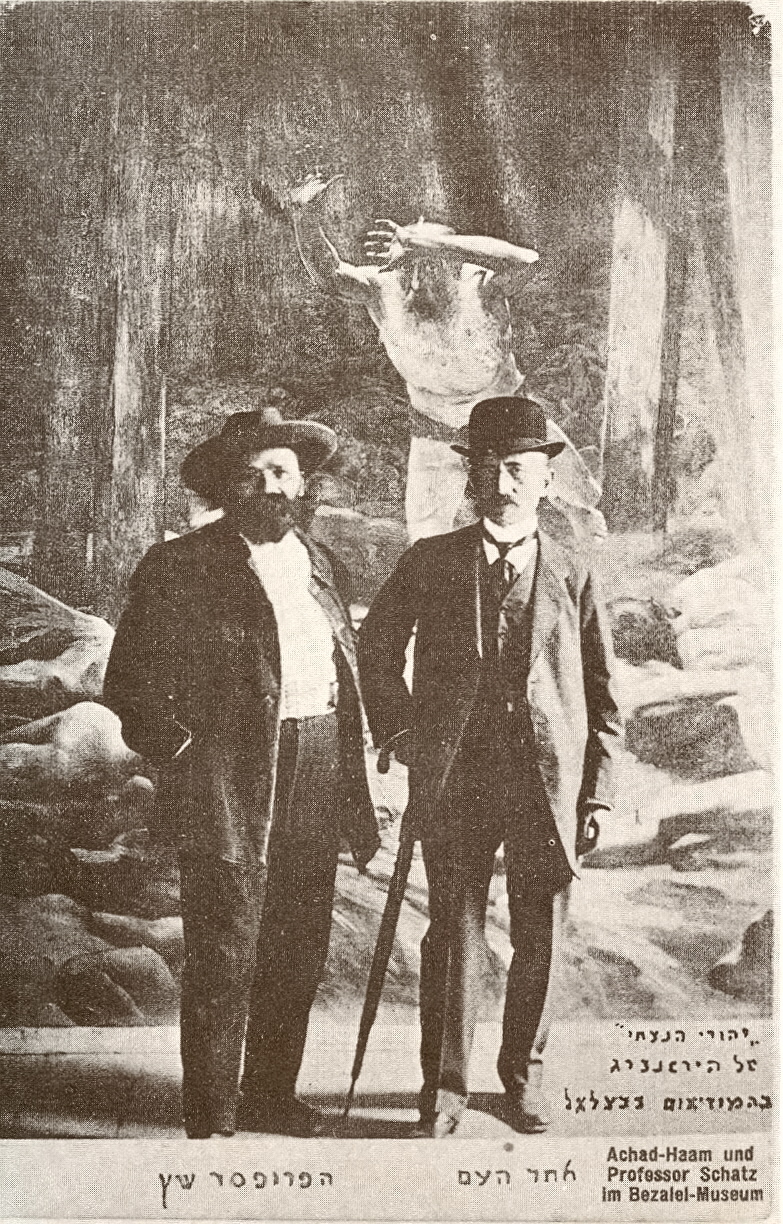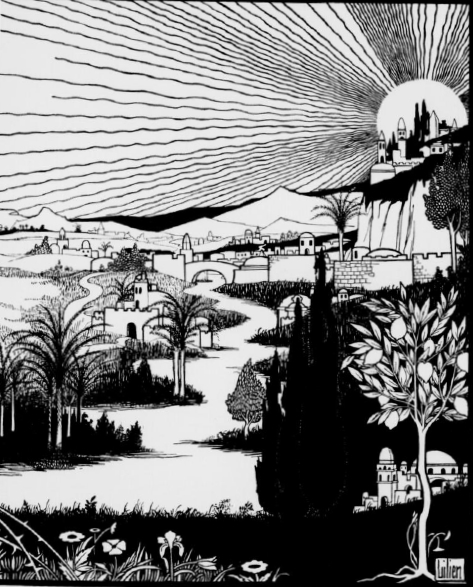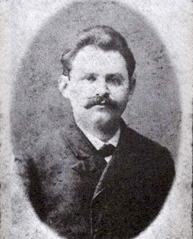|
Ahad Ha-Am
Asher Zvi Hirsch Ginsberg (18 August 1856 – 2 January 1927), primarily known by his Hebrew name and pen name Ahad Ha'am ( he, אחד העם, lit. 'one of the people', Genesis 26:10), was a Hebrew essayist, and one of the foremost pre-state Zionist thinkers. He is known as the founder of cultural Zionism. With his secular vision of a Jewish "spiritual center" in Israel, he confronted Theodor Herzl. Unlike Herzl, the founder of political Zionism, Ha'am strived for "a Jewish state and not merely a state of Jews". Biography Asher Zvi Hirsch Ginsberg (Ahad Ha'am) was born in Skvyra, in the Kiev Governorate of the Russian Empire (present-day Ukraine) to pious well-to-do Hasidic parents. At eight years old, he began to teach himself to read Russian. His father, Isaiah, sent him to heder until he was 12. When Isaiah became the administrator of a large estate in a village in the Kiev district, he moved the family there and took private tutors for his son, who excelled at his studies. G ... [...More Info...] [...Related Items...] OR: [Wikipedia] [Google] [Baidu] |
Skvyra
Skvyra ( uk, Скви́ра, ; Yiddish: skver, סקווער) is a city in Bila Tserkva Raion, Kyiv Oblast (region) of central Ukraine. Skvyra has an area of . It hosts the administration of Skvyra urban hromada, one of the hromadas of Ukraine. Its population is approximately . History The ancient town of Skvyra was completely destroyed at the end of the 16th century. In 1736, Skvyra was mentioned as a village (''selo'') leased by a Jewish lessee. According to the census of 1765, there were 124 houses in Skvyra, 51 of which belonged to Jews. In 1775, 116 Jews lived in Skvyra, in 1784 there were 204, and in 1787, 144. After Skvyra was included in the Pale of Settlement the town's Jewish community increased. Its Jewish population was 2,184 in 1847 and grew to 8,910 in 1897 — 49.5% of the general population. At the end of the 19th century Skvyra had seven synagogues, a parochial school, a hospital, a pharmacist and a district doctor. Many Jews were engaged in grain and timber exp ... [...More Info...] [...Related Items...] OR: [Wikipedia] [Google] [Baidu] |
Shlomo Ginossar
Shlomo Ginossar, (October 16, 1889, Odessa, Ukraine – January 1, 1969, Tel Aviv) son of Ahad Ha'am was the chief Administrator at Hebrew University and was Israel’s Ambassador to Italy from 1959 until 1961. Personal life Born Shlomo Ginzberg, he changed the family name to Ginossar while ambassador. He migrated with his family from Russian to the Ottoman Empire when young. He met his wife Rosa Rosa or De Rosa may refer to: People *Rosa (given name) * Rosa (surname) *Santa Rosa (female given name from Latin-a latinized variant of Rose) Places *223 Rosa, an asteroid *Rosa, Alabama, a town, United States * Rosa, Germany, in Thuringia, G ... because their fathers were friends.''Encyclopaedia Judaica'', 2 ed., vol. 7, Ginossar (Née Hacohen), Rosa, Macmillan Reference USA, 2007, pp. 607-608 Together, they went to study at the University of Paris around 1910 and married in Switzerland in 1917. References Ambassadors of Israel to Italy Hebrew University of Jerusalem Unive ... [...More Info...] [...Related Items...] OR: [Wikipedia] [Google] [Baidu] |
Ha-Melitz
''Ha-Melitz'' or ''HaMelitz'' (Hebrew: ) was the first Hebrew newspaper in the Russian Empire. It was founded by Alexander Zederbaum in Odessa in 1860. History ''Ha-Melitz'' first appeared as a weekly, and it began to appear daily in 1886. From 1871, it was published in Saint Petersburg. Publication was suspended several times for lack of support or by order of the authorities. In 1893, Leon Rabinowitz succeeded Zederbaum as the editor. ''Ha-Melitz'' was a representative of the progressive or ''haskalah'' movement, and even so severe a critic as Abraham Kovner admitted that it had been "more useful to the Jews than have the other Hebrew newspapers" (''Ḥeḳer Dabar,'' p. 52 ff., Warsaw, 1866). While it was not so literary or scientific as some of its contemporaries, ''Ha-Melitz'' usually had more news and debates of interest, and was consequently more popular. J. A. Goldenblum was for many years associated with Zederbaum in its publication. Abraham Shalom Friedberg and Ju ... [...More Info...] [...Related Items...] OR: [Wikipedia] [Google] [Baidu] |
Diaspora
A diaspora ( ) is a population that is scattered across regions which are separate from its geographic place of origin. Historically, the word was used first in reference to the dispersion of Greeks in the Hellenic world, and later Jews after the Babylonian exile. The word "diaspora" is used today in reference to people who identify with a specific geographic location, but currently reside elsewhere. Examples of notably large diasporic populations are the Assyrian–Chaldean–Syriac diaspora, which originated during and after the early Arab-Muslim conquests and continued to grow in the aftermath of the Assyrian genocide; the southern Chinese and Indians who left their homelands during the 19th and 20th centuries; the Irish diaspora that came into existence both during and after the Great Famine; the Scottish diaspora that developed on a large scale after the Highland Clearances and Lowland Clearances; the nomadic Romani population from the Indian subcontinent; the Ita ... [...More Info...] [...Related Items...] OR: [Wikipedia] [Google] [Baidu] |
Tom Segev
Tom Segev ( he, תום שגב; born March 1, 1945) is an Israeli historian, author and journalist. He is associated with Israel's New Historians, a group challenging many of the country's traditional narratives. Biography Segev was born in Jerusalem. His parents, Ricarda (née Meltzer) and Heinz Schwerin were artists who had met at the Bauhaus art school and fled Nazi Germany in 1935 due to their Communist orientation (Heinz was also Jewish). His mother was a photographer; his father, an architect and toy manufacturer, was killed on guard duty in Jerusalem in the 1948 Arab–Israeli War. Segev's first language was German; his mother never learned Hebrew beyond a basic level. He earned a BA in history and political science from the Hebrew University of Jerusalem and a PhD in history from Boston University in the 1970s. His sister is the German politician Jutta Oesterle-Schwerin. Journalism career Segev worked during the 1970s as a correspondent for ''Maariv'' in Bonn. He was ... [...More Info...] [...Related Items...] OR: [Wikipedia] [Google] [Baidu] |
Ha-Shiloaḥ
''Ha-Shiloaḥ'' () was a Hebrew-language literary journal, founded by Ahad Ha'am and the Ahi'asaf Publishing House in 1896. He edited the journal until December 1902, whereupon it came under the editorship of historian Joseph Klausner. It ceased publication in 1926. The journal's title refers to the text of . Initial financing for Ha-Shiloaḥ was provided by businessman Kalonymus Ze’ev Wissotzky under the condition that Ahad Ha'am would be editor. Since it was difficult to obtain a license from the Russian government to publish the journal due to censorship laws, it was first printed in Berlin from 1896 until 1900 and then later in Krakow from 1901 to 1905. Publication was suspended in 1905 for two years as a result of the Russian Revolution. Permission to publish in Russia was granted in 1907 while editing was done in Odessa and Warsaw, while the vast majority of readership lived in Russia. ''Ha-Shiloaḥ'' experienced financial problems due to the considerable increase in pr ... [...More Info...] [...Related Items...] OR: [Wikipedia] [Google] [Baidu] |
First Zionist Congress
The First Zionist Congress ( he, הקונגרס הציוני הראשון) was the inaugural congress of the Zionist Organization (ZO) held in Basel (Basle), from August 29 to August 31, 1897. 208 delegates and 26 press correspondents attended the event. It was convened and chaired by Theodor Herzl, the founder of the modern Zionism movement. The Congress formulated a Zionist platform, known as the Basel program, and founded the Zionist Organization. It also adopted the Hatikvah as its anthem (already the anthem of Hovevei Zion and later to become the national anthem of the State of Israel). The conference was covered by the international press, making a significant impression; the publicity subsequently inspired the antisemitic forgery ''The Protocols of the Elders of Zion''. History The first Zionist Congress was convened by Theodor Herzl as a symbolic parliament for the small minority of Jewry in agreement with the implementation of Zionist goals. While Jewish major ... [...More Info...] [...Related Items...] OR: [Wikipedia] [Google] [Baidu] |
Eretz Israel
The Land of Israel () is the traditional Jewish name for an area of the Southern Levant. Related biblical, religious and historical English terms include the Land of Canaan, the Promised Land, the Holy Land, and Palestine (see also Israel (other)). The definitions of the limits of this territory vary between passages in the Hebrew Bible, with specific mentions in Genesis 15, Exodus 23, Numbers 34 and Ezekiel 47. Nine times elsewhere in the Bible, the settled land is referred as "from Dan to Beersheba", and three times it is referred as "from the entrance of Hamath unto the brook of Egypt" (1 Kings 8:65, 1 Chronicles 13:5 and 2 Chronicles 7:8). These biblical limits for the land differ from the borders of established historical Israelite and later Jewish kingdoms, including the United Kingdom of Israel, the two kingdoms of Israel (Samaria) and Judah, the Hasmonean Kingdom, and the Herodian kingdom. At their heights, these realms ruled lands with similar but ... [...More Info...] [...Related Items...] OR: [Wikipedia] [Google] [Baidu] |
Palestine (region)
Palestine ( el, Παλαιστίνη, ; la, Palaestina; ar, فلسطين, , , ; he, פלשתינה, ) is a geographic region in Western Asia. It is usually considered to include Israel and the State of Palestine (i.e. West Bank and Gaza Strip), though some definitions also include part of northwestern Jordan. The first written records to attest the name of the region were those of the Twentieth dynasty of Egypt, which used the term "Peleset" in reference to the neighboring people or land. In the 8th century, Assyrian inscriptions refer to the region of "Palashtu" or "Pilistu". In the Hellenistic period, these names were carried over into Greek, appearing in the Histories of Herodotus in the more recognizable form of "Palaistine". The Roman Empire initially used other terms for the region, such as Judaea, but renamed the region Syria Palaestina after the Bar Kokhba revolt. During the Byzantine period, the region was split into the provinces of Palaestina Prima, Palaestin ... [...More Info...] [...Related Items...] OR: [Wikipedia] [Google] [Baidu] |
Zion
Zion ( he, צִיּוֹן ''Ṣīyyōn'', LXX , also variously transliterated ''Sion'', ''Tzion'', ''Tsion'', ''Tsiyyon'') is a placename in the Hebrew Bible used as a synonym for Jerusalem as well as for the Land of Israel as a whole (see Names of Jerusalem). The name is found in 2 Samuel (5:7), one of the books of the Hebrew Bible dated to before or close to the mid-6th century BCE. It originally referred to a specific hill in Jerusalem ( Mount Zion), located to the south of Mount Moriah (the Temple Mount). According to the narrative of 2 Samuel 5, Mount Zion held the Jebusite fortress of the same name that was conquered by David and was renamed the City of David. That specific hill ("mount") is one of the many squat hills that form Jerusalem, which also includes Mount Moriah (the Temple Mount), the Mount of Olives, etc. Over many centuries, until as recently as the Ottoman era, the city walls of Jerusalem were rebuilt many times in new locations, so that the particular hill ... [...More Info...] [...Related Items...] OR: [Wikipedia] [Google] [Baidu] |
Hovevei Zion
Hovevei Zion ( he, חובבי ציון, lit. ''hose who areLovers of Zion''), also known as Hibbat Zion ( he, חיבת ציון), refers to a variety of organizations which were founded in 1881 in response to the Anti-Jewish pogroms in the Russian Empire and were officially constituted as a group at a conference led by Leon Pinsker in 1884. The organizations are now considered the forerunners and foundation-builders of modern Zionism. Many of the first groups were established in Eastern European countries in the early 1880s with the aim to promote Jewish immigration to Palestine, and advance Jewish settlement there, particularly agricultural. Most of them stayed away from politics. History Since the first centuries of the Common Era most Jews had lived outside Palestine, although there had been a constant presence of Jews there as well. According to the Bible and Judaism, Eretz Israel was promised to the Jews by God. The Jewish diaspora began in 586 BCE during the Babylonian ... [...More Info...] [...Related Items...] OR: [Wikipedia] [Google] [Baidu] |







